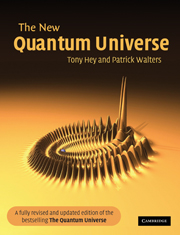Book contents
- Frontmatter
- Contents
- Preface
- Prologue
- Route map
- 1 Waves versus particles
- 2 Heisenberg and uncertainty
- 3 Schrödinger and matter waves
- 4 Atoms and nuclei
- 5 Quantum tunnelling
- 6 Pauli and the elements
- 7 Quantum co-operation and superfluids
- 8 Quantum jumps
- 9 Quantum engineering
- 10 Death of a star
- 11 Feynman rules
- 12 Weak photons and strong glue
- 13 Afterword – quantum physics and science fiction
- Epilogue
- Appendix 1 The size of things
- Appendix 2 Solving the Schrödinger equation
- Glossary
- Quotations and sources
- Suggestions for further reading
- Photo-credits
- Name index
- Subject index
13 - Afterword – quantum physics and science fiction
Published online by Cambridge University Press: 05 October 2013
- Frontmatter
- Contents
- Preface
- Prologue
- Route map
- 1 Waves versus particles
- 2 Heisenberg and uncertainty
- 3 Schrödinger and matter waves
- 4 Atoms and nuclei
- 5 Quantum tunnelling
- 6 Pauli and the elements
- 7 Quantum co-operation and superfluids
- 8 Quantum jumps
- 9 Quantum engineering
- 10 Death of a star
- 11 Feynman rules
- 12 Weak photons and strong glue
- 13 Afterword – quantum physics and science fiction
- Epilogue
- Appendix 1 The size of things
- Appendix 2 Solving the Schrödinger equation
- Glossary
- Quotations and sources
- Suggestions for further reading
- Photo-credits
- Name index
- Subject index
Summary
You read too many novels!
Richard FeynmanPrelude: the atom and the nucleus
Now that the atomic basis of matter is taught routinely in schools, it is difficult to imagine the suspicion and hostility towards atoms that existed at the end of the nineteenth century. This seems especially strange since the idea of atoms has been around since the fifth century BC in the writings of the Greek philosophers Leucippus and Democritus. Such distrust of the ‘atomic hypothesis’ is all the more surprising given that Daniel Bernoulli, James Clerk Maxwell and Ludwig Boltzmann had all successfully used an atomic model of gases – with atoms as tiny hard spheres that could move and collide like billiard balls – to explain many thermodynamic properties of gases. Nonetheless, it was only with Einstein's famous 1905 paper on ‘Brownian’ motion – which explained the observed random jiggling motion of grains of pollen floating in water in terms of collisions with water molecules – that almost all of the doubters were silenced and the atomic hypothesis became generally accepted.
As we have seen, the idea of atoms as tiny, hard, indestructible spheres only survived until 1911. It was then that Ernest Rutherford came up with the startling discovery that most of the atom was empty space! From his calculations of the scattering of alpha particles by atoms, Rutherford deduced that almost all the mass of the atom, and all the positive charge, must be concentrated in a tiny sphere much smaller than the apparent size of the atom.
- Type
- Chapter
- Information
- The New Quantum Universe , pp. 285 - 312Publisher: Cambridge University PressPrint publication year: 2003



